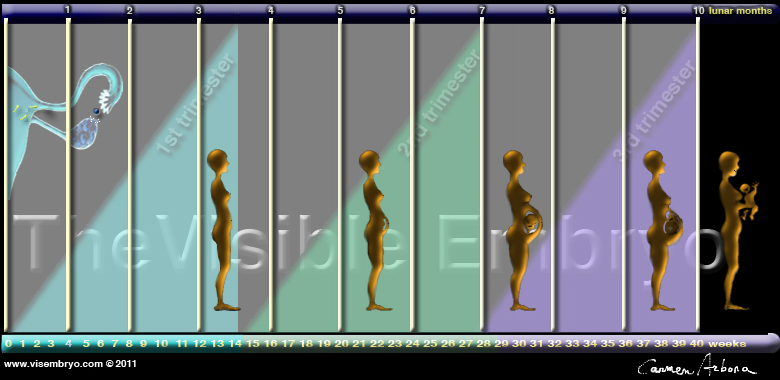|
|
Fetal Timeline Maternal Timeline News News Archive Sep 9, 2015

(TOP) Dendrite branching in wild type fruit fly, (MIDDLE) Centrosomin mutant dendrites ,
(BOTTOM) Abrupt mutant dendrites. Note the increased branching in the mutant dendrites.
Image Credit: RIKEN Brain Science Institute, Japan
|
|
| |
|
|
|
How neurons branch
For more than a hundred years, people have known that dendrites project off of neurons to receive electrical impulses of information through synapse exchanges. As we grow in experience, they grow, creating tree-like arbors different in shape depending on the neuron. Now, a factor has been discovered that helps shape these arbors.
Dendrites extend from a neuron and branch as microtubules push them away from the neuron cell body. Microtubules are often compared to cell scaffolding, built on site and growing from one spot outward. To determine how microtubule growth and dendrite branching is regulated, researchers at the RIKEN Brain Science Institute in Japan experimented with sensory neurons in the Drosophila or fruit fly.

A: Microtubule polarity patterns in typical vertebrate axons and dendrites. Axons contain uniformly
oriented microtubules (plus-end-distal), while dendrites contain non-uniformly oriented microtubules.
Image Credit: Peter W. Baas, Shen Lin, Neurobiology, Drexel University, College of Medicine (1)
The results of their observations are published in Nature Neuroscience, and reveal how the protein centrosomin can prevent dendrites from branching.
The scientists focused on a type of Drosophila sensory neuron that has very limited dendrite branching, and a transcription factor called Abrupt.
When expressed (or "read"), the Abrupt transcription factor reduces dedrite arbors, but its absence leads to complex arbors. So, researchers tested a group of candidate proteins from molecular pathways initiated by Abrupt. They were looking for one protein that regulates microtubules, and they found centrosomin.
Centrosomin is a protein that builds microtubule-based structures needed in cell division. The absense of centrosomin resulted in extensive dendritic branching, while increasing centrosomin blocked an increase in branching initiated by a lack of Abrupt.
High levels of Abrupt = absense of centrosomin + increased dendrites
Low levels of Abrupt = increased centrosomin + less dendrite branching
Working in conjunction with another protein called pericentrin, centrosomin would even control where new microtubules form which affects dendrites. When one end of a microtubule is attached as it grows, it does not push out new dendritic branches. However, if microtubules form at no particular location as they grow, new dendritic branches are more likely to form.
Further testing revealed that centrosomin acts as a glue fixing microtubules to Golgi bodies. Golgi bodies gather simple molecules, combining them into more complex molecules, then stores them if not used immediately. The presence of centosomin promotes less complex dendrite branching.
"The shape and complexity of neuronal dendrite arbors are often disrupted in neurological diseases. It turns out the two microtubule regulators we found in this study of Drosophila neurons — centrosomin and pericentrin — are encoded by genes mutated in some human brain disorders. As we learn more about how neurons control the growth of dendrites it will help us understand these diseases more completely, and we may learn how to initiate and direct neuron growth as therapy for diseases and after neuronal injury."
Adrian W. Moore PhD, team leader , Laboratory for Genetic Control of Neuronal Architecture, RIKEN Brain Science Institute, Wako-shi, Saitama, Japan
Abstract
Neuronal dendrite branching is fundamental for building nervous systems. Branch formation is genetically encoded by transcriptional programs to create dendrite arbor morphological diversity for complex neuronal functions. In Drosophila sensory neurons, the transcription factor Abrupt represses branching via an unknown effector pathway. Targeted screening for branching-control effectors identified Centrosomin, the primary centrosome-associated protein for mitotic spindle maturation. Centrosomin repressed dendrite branch formation and was used by Abrupt to simplify arbor branching. Live imaging revealed that Centrosomin localized to the Golgi cis face and that it recruited microtubule nucleation to Golgi outposts for net retrograde microtubule polymerization away from nascent dendrite branches. Removal of Centrosomin enabled the engagement of wee Augmin activity to promote anterograde microtubule growth into the nascent branches, leading to increased branching. The findings reveal that polarized targeting of Centrosomin to Golgi outposts during elaboration of the dendrite arbor creates a local system for guiding microtubule polymerization.
Authors
Cagri Yalgin, Saman Ebrahimi, Caroline Delandre, Li Foong Yoong, Saori Akimoto, Heidi Tran, Reiko Amikura, Rebecca Spokony, Benjamin Torben-Nielsen, Kevin P White & Adrian W Moore
Reference
Yalgin C, Ebrahimi S, Delandre C, Yoong LF, Akimoto S, Tran H, Amikura R, Spokony R, Torben-Nielsen B, White KP, and Moore AW (2015). Centrosomin represses dendrite branching by orienting microtubule nucleation. Nature Neuroscience. doi: 10.1038/nn.4099.
Return to top of page
|




